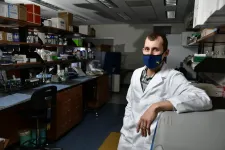Study finds ghost forest 'tree farts' contribute to greenhouse gas emissions
2021-05-12
(Press-News.org) A new study from North Carolina State University finds that greenhouse gas (GHG) emissions from standing dead trees in coastal wetland forests - colloquially called "tree farts" - need to be accounted for when assessing the environmental impact of so-called "ghost forests."
In the study, researchers compared the quantity and type of GHG emissions from dead tree snags to emissions from the soil. While snags did not release as much as the soils, they did increase GHG emissions of the overall ecosystem by about 25 percent. Researchers say the findings show snags are important for understanding the total environmental impact of the spread of dead trees in coastal wetlands, known as ghost forests, on GHG emissions.
"Even though these standing dead trees are not emitting as much as the soils, they're still emitting something, and they definitely need to be accounted for," said the study's lead author Melinda Martinez, a graduate student in forestry and environmental resources at NC State. "Even the smallest fart counts."
In the study, researchers measured emissions of carbon dioxide, methane and nitrous oxide from dead pine and bald cypress snags in five ghost forests on the Albemarle-Pamlico Peninsula in North Carolina, where researchers have been tracking the spread of ghost forests due to sea-level rise.
"The transition from forest to marsh from these disturbances is happening quickly, and it's leaving behind many dead trees," Martinez said. "We expect these ghost forests will continue to expand as the climate changes."
Using portable gas analyzers, researchers measured gases emitted by snags and from soils in each forest in 2018 and 2019. Overall average emissions from soils were approximately four times higher than average emissions from snags in both years. And while snags did not contribute as much as soils, researchers said they do contribute significantly to emissions.
In addition to finding that soils emit more GHGs than snags, the work lays the foundation for the researchers' ongoing work to understand the role snags are playing in emissions - whether they prevent emissions, like corks, or release them like straws. That is an area of future research they're currently continuing to explore.
"We started off this research wondering: Are these snags straws or corks?" said study co-author Marcelo Ard?n, associate professor of forestry and environmental sciences at NC State. "Are they facilitating the release from soils, or are they keeping the gases in? We think that they act as straws, but as a filtered straw. They change those gases, as the gases move through the snags."
INFORMATION:
The study, "Drivers of Greenhouse Gas Emissions from Standing Dead Trees in Ghost Forests," was published online in Biogeochemistry on May 10, 2021. Funding was provided by the National Science Foundation under grant DEB1713592 and a 2019 North Carolina Sea Grant/SpaceGrant Fellowship.
Note to editors: The abstract follows.
"Drivers of Greenhouse Gas Emissions from Standing Dead Trees in Ghost Forests"
Authors: Melinda Martinez and Marcelo Ard?n.
Published online in Biogeochemistry on May 10, 2021.
DOI: 10.1007/s10533-021-00797-5
Abstract: Coastal freshwater forested wetlands are rapidly transitioning from forest to marsh, leaving behind many standing dead trees (snags) in areas often called 'ghost forests'. Snags can act as conduits for soil produced greenhouse gases (GHG) and can also be sources as they decompose. Thus, snags have the potential to contribute GHGs to the atmosphere, but emissions are not well understood. We assessed GHG emissions (carbon dioxide - CO2, methane - = CH4, and nitrous oxide - N2O) from snags and soils in five ghost forests along a salinity gradient on the coast of North Carolina, USA. Mean (± SE) soil GHG fluxes (416 ± 44 mg CO2 m-2 hr-1 , 5.9 ± 1.9 mg CH4 m-2 hr -1 = , and 0.1 ± 0.06 mg N2O m-2 hr-1 ) were ~4 times greater than mean snag GHGs (116 ± 15 mg CO2 m-2 hr-1 , 0.3 ± 0.09 mg CH4 m-2 hr- = 1 , and 0.04 ± 0.009 mg N2O m-2 hr-1 = ). Hydrological conditions and salinity influenced soil GHG fluxes between the 48 two field campaigns, but snags were less predictable and more variable. Snag and soil CO2/N2O fluxes were influenced by similar environmental parameters. The drivers for soil and snag CH4 however, were often not the same and at times oppositely correlated. Our results illustrate the need to further research into the drivers and importance of GHG = emissions from snags, and the need to include tree stems into ecosystem GHG research.
ELSE PRESS RELEASES FROM THIS DATE:
2021-05-12
The immune system's main job is identifying things that can make us sick. In the language of immunology, this means distinguishing "self" from "non-self": The cells of our organs are self, while disease-causing bacteria and viruses are non-self.
But what about the billions of bacteria that live in our guts and provide us with benefits like digesting food and making vitamins? Are they friend or foe?
This isn't only a philosophical question. An immune system that mistakes our good gut bacteria for an enemy can cause a dangerous type of inflammation in the intestines called colitis. An immune system that looks the other way while gut microbes spill past their assigned borders is equally dangerous. Understanding ...
2021-05-12
Our body's relationship with bacteria is complex. While infectious bacteria can cause illness, our gut is also teaming with "good" bacteria that aids nutrition and helps keep us healthy. But even the "good" can have bad effects if these bacteria end up in tissues and organs where they're not supposed to be.
Now, research published in END ...
2021-05-12
COLUMBUS, Ohio - Neighborhoods without opioid treatment providers likely serve as a widespread barrier to care for those who are ready to seek help, a new study has found.
The study, led by researchers at The Ohio State University, appears today (May 12, 2021) in the journal PLOS ONE.
"The study identified clear opioid treatment deserts that undoubtedly stand in the way of access to needed care and that likely exist throughout the state and the nation. These are areas where treatment providers should be setting up shop - we need a surge of resources into these areas," said Ayaz Hyder, an assistant professor in Ohio State's College of Public Health ...
2021-05-12
Elephant Seals' Extreme Diving Allows Them to Exploit Deep Ocean Niche
Using data captured by video cameras and smart accelerometers attached to female elephant seals, Taiki Adachi and colleagues show that the animals spend at least 80% of their day foraging for fish, feeding between 1,000 and 2,000 times per day. The unique glimpse at elephant seal foraging strategy shows how these large marine mammals exploit a unique ocean niche filled with small fish. The findings also may offer a way to monitor the health of the mesopelagic zone, the dark and cold ocean "twilight zone" ecosystem at 200 to 1,000 meters deep. Small mesopelagic fish dominate the world's ocean ...
2021-05-12
A Johns Hopkins University-led team has created an inexpensive portable device and cellphone app to diagnose gonorrhea in less than 15 minutes and determine if a particular strain will respond to frontline antibiotics.
The invention improves on traditional testing in hospital laboratories and clinics, which typically takes up to a week to deliver results--time during which patients can unknowingly spread their infections. The team's results appear today in Science Translational Medicine.
"Our portable, inexpensive testing platform has the potential to change the game when it comes to diagnosing and enabling rapid treatment of sexually transmitted infections," said team leader Tza-Huei Wang, a professor of mechanical engineering ...
2021-05-12
People who are genetically more likely to suffer from cardiovascular diseases may benefit from boosting a biomarker found in fish oils, a new study suggests.
In a genetic study in 1,886 Asian Indians published in PLOS ONE today (Wednesday 12 May), scientists have identified the first evidence for the role of adiponectin, an obesity-related biomarker, in the association between a genetic variation called omentin and cardiometabolic health.
The team, led by Professor Vimal Karani from the University of Reading, observed that the role of adiponectin was linked to cardiovascular disease markers that were independent of common and central obesity among the Asian Indian population. ...
2021-05-12
Misleading claims about COVID-19 vaccines can negatively impact public confidence in immunisation uptake, a new UNSW Sydney study reveals.
A new study published in the scientific journal PLOS ONE revealed over 103 million people globally liked, shared, retweeted or reacted with an emoji to misinformation and conspiracy theories about COVID-19 vaccines.
In 2020, a social media post claiming, "a new vaccine for COVID-19 will alter a person's DNA and result in them becoming genetically modified" was circulated on Facebook accounts in Australia. Up until August 21, 2020, this false claim had attracted 360 shares and was viewed 32,000 times.
The study, led by UNSW researchers, ...
2021-05-12
Quick: Pick your three favorite fast-food restaurants.
If you're like many people, McDonald's, Wendy's, and Burger King may come to mind--even if you much prefer In-N-Out or Chick-fil-A.
A new study from UC Berkeley's Haas School of Business and UC San Francisco's Department of Neurology found that when it comes to making choices, we surprisingly often forget about the things we like best and are swayed by what we remember. The paper, publishing this week in the journal Proceedings of the National Academy of Sciences, combines insights from economics and psychology with decision-making experiments and fMRI brain scans to examine how our imperfect memories affect our decision making.
"Life is not a multiple-choice test," says Berkeley ...
2021-05-12
Autoimmune diseases have something in common with horses, bachelor's degrees and daily flossing habits: women are more likely to have them.
One reason for autoimmune diseases' prevalence in women may be sex-based differences in inflammation. In a new study, West Virginia University researcher Jonathan Busada investigated how sex hormones affect stomach inflammation in males and females. He found that androgens--or male sex hormones--may help to keep stomach inflammation in check.
"Stomach cancer is primarily caused by rampant inflammation," said Busada, an assistant professor in the School of ...
2021-05-12
Brown bears that are more inclined to grate and rub against trees have more offspring and more mates, according to a University of Alberta study. The results suggest there might be a fitness component to the poorly understood behaviour.
"As far as we know, all bears do this dance, rubbing their back up against the trees, stomping the feet and leaving behind odours of who they are, what they are, what position they're in, and possibly whether they are related," said Mark Boyce, an ecologist in the Department of Biological Sciences.
"What we were able to show is that both males and females have more offspring if they rub, more surviving offspring if they rub and they have more mates if they rub."
The research team led by Boyce ...
LAST 30 PRESS RELEASES:
[Press-News.org] Study finds ghost forest 'tree farts' contribute to greenhouse gas emissions

